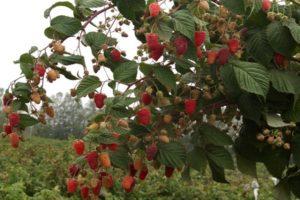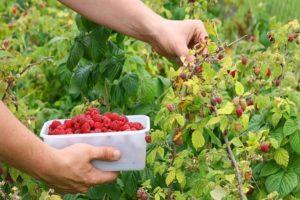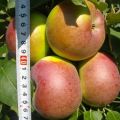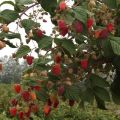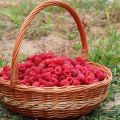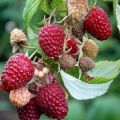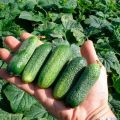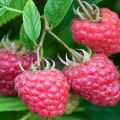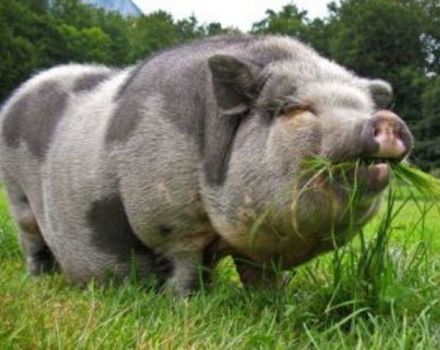Description and characteristics of Arbat raspberries, cultivation technology
Raspberries of the Arbat variety are known for their taste and strong shoots. For all characteristics, this hybrid meets the standards.
Breeding history of the variety
To create a hybrid, 2 varieties of Scottish raspberries were taken. V.V.Kichina took part in the development. The first copy was received in 1988 and officially adopted in 1996.
Description and characteristics of the Arbat variety
This raspberry variety attracts the attention of gardeners due to its good qualities. The yield of Arbat raspberries directly depends on this. Gardeners are interested in getting the best specimens, since the variety of varieties is very large.

Bushes
The height of the bushes is up to two meters. The Arbat raspberry has rather strong and strong shoots that form the bush itself. The crown itself is spreading. There are no thorns, which allows you to pick berries without injury or damage. Branches 1-2 years old are considered young shoots. They are usually light green to light brown in color. Fruiting begins on shoots that have reached the age of two years, as well as on more mature branches.
Raspberries are endowed with a huge number of leaves, their size also depends on age. Usually there are small denticles along the edges of the leaf. Shades of foliage from dark green to light with a waxy coating.
Berries
The berries of the plant are large, their length is 2-4 centimeters. Weight from 5 to 13 grams. The berries are oblong, resembling a cone. The color of the Arbat raspberry variety is deep red or dark red. The seeds are very small and hard to spot. The fruits are juicy and have an excellent sweet and sour taste. But, unfortunately, the smell is almost not felt.

Scope of fruits
Malina Arbat is not a remontant variety. At home, berries are most often used for spinning compotes, preserves and jams. It is also very useful to eat fresh berries or add to pies and other pastries.
Sometimes the fruits are dried or frozen in the freezer to more or less preserve their original appearance.
Disease and pest resistance
The plant is quite resistant to various diseases and attacks of pests, but like other varieties, it can be influenced by infection. The most important "guests" of this variety are the raspberry beetle and spider mite.
These insects hibernate in the soil, so it is important to loosen the ground when preparing the raspberry tree for winter. Also, from time to time, preventive spraying and treatment of plants with special substances are carried out to reduce the risk of disease.

Drought resistance, frost resistance
Arbat raspberries need constant watering, since the size and taste of the fruits, as well as the overall productivity of the bush, depend on this. Speaking of winter hardiness, it can be noted that the plant tolerates winters well, therefore it is grown in the northern regions of the country. Only in this case, to increase the chances of survival, the bushes are insulated. Raspberries are drought tolerant, but this should not be overused as sparse watering will kill the plant.
Fruiting and productivity
Arbat belongs to the list of high-yielding varieties. Medium early fruiting, the first berries are harvested in early June to August. The date varies depending on the region of cultivation and on the weather conditions. Lack of sun during the first months of summer can slow down the maturation process.
In general, the yield of the variety is assessed by gardeners as suitable by the standards.

Positive and negative sides of the variety
Like any other plant, raspberries have their pros and cons:
- The variety is famous for its high yield, regular fruiting.
- Raspberry berries are large and sweet.
- There are almost no thorns.
- Raspberries are resistant to disease, cold and drought.
- The fruits can be transported, they will not lose their taste and shape.
- The downside may be a weakness for some diseases.
Growing raspberries
The planting itself is not difficult, here a very important part is precisely caring for the plants. Gardeners are trying to provide the raspberry with the necessary fertilizers, high-quality watering.

When to plant
For planting in spring or autumn, it is important to choose seedlings with a closed root system. If there are no such seedlings, then planting is carried out in the fall. Choose a sunny day. It is important that there is no strong wind, as a young plant may not withstand strong gusts, and the root system is not yet stable in the soil.
Selecting and preparing a landing site
They choose an area with fertile soil, the acidity is low, the area is sunny. If the soil lacks nutrients, then before planting it is fertilized and mulched. The area should not be closed by trees or a wall, as tall stands will block raspberries from the sun, which will make their growth very slow and the fruits small.
It is important to plant raspberries away from other plants that attack pests. If raspberries are grown for several years, then the planting area is changed from time to time so that it has the opportunity to "rest".

Planting seedlings
Saplings are chosen without characteristic damage and diseases. Check the root system in advance. Before planting the plant, it is previously placed in a solution of potassium permanganate. Before planting, the roots are placed in a mixture of clay and manure or humus.
The planting process begins with digging a hole 45-50 centimeters wide. Depth 30-35 centimeters. Chips or bark are placed at the bottom of the pit. You can also add peat or rotted sawdust. Then add a layer of fertile soil.
The seedling is lowered into the hole, observing the position of the roots. In order for the plants to strengthen, sometimes two seedlings are placed in one hole, which later grow together into one bush. After that, the pit with raspberries is covered with earth and compacted well. The soil is lightly trampled and watered.
Raspberry Care Tips
Grooming is the most important part of growing a raspberry tree. It is important to regularly water the plants, feed and trim.

How to water
Although the variety can go without water for a long time, this, of course, will harm the raspberries.Watering is carried out not so often, but this procedure should be abundant, since the roots of the Arbat raspberry grow very deeply.
To make the liquid better absorbed, after irrigation, the soil around the bush is loosened.
Watering is stopped in November, when preparations for the winter period begin.
What to feed
Fertilizers begin to be applied in the second year of life. The first feeding is carried out in the spring. Usually these are nitrogen fertilizers. Inorganic fertilizers are applied annually. Manure, humus is used every two years.
In May, a mullein is used with water, which can be applied as watering. In July, the drug "Ideal" is used. In the last month of summer, a solution of potassium sulfate and water is used.

Pruning
Branches and shoots that have finished fruiting are cut under the base of the bush. In the spring, old shoots are cut to the base, and young ones only at the top. Tie up specimens only as needed, in cases where the plant is weak or there are too many berries on it.
Preparing for winter
In warm regions of the country, raspberries are not insulated, but only cut off. In areas where the temperature drops to 30 degrees below zero, the shoots are bent and covered.

Disease and pest control
Often the cause of the death of the bush is pests and diseases. In order to avoid drying out, from time to time the raspberries are treated with different solutions. To combat the raspberry beetle, use "Karbofos". To get rid of this insect, they also cut out old and diseased bushes, and in the spring they treat Arbat with Bordeaux liquid.
In hot weather, spider mites can appear on raspberries. Their invasion threatens the death of plants in the first year of life. Acaricide "Actellik 500 EC" is used for the fight. This is done when the flowers are just beginning to form.
Harvesting and storage
Another positive quality of this hybrid is that after ripening the berries do not crumble. The fruit is easy to harvest due to the lack of thorns.
Once harvested, the berries are used for culinary purposes. Fruit juice is released only on the second day. You can use drying after harvesting, which will allow the product to be used as a medicinal product.

Reproduction methods
Reproduction is carried out by dividing the bush, this method gives more chances for successful breeding. Root suckers are also used.
